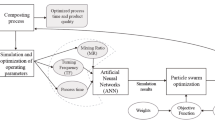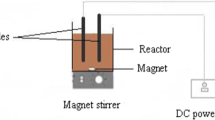Abstract
An electrochemical biosensor based on the immobilization of laccase on magnetic core-shell (Fe3O4–SiO2) nanoparticles was combined with artificial neural networks (ANNs) for the determination of catechol concentration in compost bioremediation of municipal solid waste. The immobilization matrix provided a good microenvironment for retaining laccase bioactivity, and the combination with ANNs offered a good chemometric tool for data analysis in respect to the dynamic, nonlinear, and uncertain characteristics of the complex composting system. Catechol concentrations in compost samples were determined by using both the laccase sensor and HPLC for calibration. The detection range varied from 7.5 × 10–7 to 4.4 × 10–4 M, and the amperometric response current reached 95% of the steady-state current within about 70 s. The performance of the ANN model was compared with the linear regression model in respect to simulation accuracy, adaptability to uncertainty, etc. All the results showed that the combination of amperometric enzyme sensor and artificial neural networks was a rapid, sensitive, and robust method in the quantitative study of the composting system.

Structure of the magnetic carbon paste electrode used in the electrochemical biosensor






Similar content being viewed by others
References
Lante A, Crapisi A, Krastanov A, Spettoli P (2000) Process Biochem 36:51–58
Topping DC, Bernard LG, O’Donoghue JL, English JC (2007) Food Chem Toxicol 45:70–78
Canofeni S, Sario SD, Mela J, Pilloton R (1994) Anal Lett 27:1659–1662
Campitelli P, Ceppi S (2008) Geoderma 144:325–333
Faure D, Bouillant ML, Jacoud C, Bally R (1996) Phytochemistry 42:357–359
Kim KR, Kim H (2000) J Chromatogr A 866:87–96
Corcia AD, Bellioni A, Madbouly MD, Marchese S (1996) J Chromatogr A 733:383–393
Miró M, Frenzel W (2003) Analyst 128:1291–1297
Yaropolov AI, Skorobogat’ko OV, Vartanov SS, Varfolomeyev SD (1994) Appl Biochem Biotech 49:257–280
Xu F (1999) Laccase: molecular properties, enzymology, and preparation of laccase. In: Flickinger MC, Drew SW (eds) Encylopedia of bioprocess technology, fermentation biocatalysis and bioseparation. Wiley, New York, pp 1545–1554
Bessant C, Saini S (1999) Anal Chem 71:2806–2813
Hajmeer MN, Basheer IA (2003) Int J Food Microbiol 82:233–243
Lek S, Guégan JF (1999) Ecol Model 120:65–73
Gutés A, Céspedes F, Alegret S, del Valle M (2005) Biosens Bioelectron 20:1668–1673
Gutés A, Céspedes F, Alegret S, del Valle M (2005) Talanta 66:1187–1196
Cortina M, Gutés A, Alegret S, del Valle M (2005) Talanta 66:1197–1206
Ni Y, Qiu P, Kokot S (2005) Anal Chim Acta 537:321–330
Sahoo GB, Ray C, Mehnert E, Keefer DA (2006) Sci Total Environ 367:234–251
Zhang Y, Zeng GM, Tang L, Huang DL, Jiang XY, Chen YN (2007) Biosens Bioelectron 22:2121–2126
Chapuis-Lardy L, Contour-Ansel D, Bernhard-Reversat F (2002) Plant Sci 163:217–222
Zeng GM, Tang L, Shen GL, Huang GH, Niu CG (2004) Int J Environ Anal Chem 84:761–774
Onkal-Engin G, Demir I, Engin SN (2005) Environ Modell Softw 20:843–850
Siripatrawan U, Linz JE, Harte BR (2006) Sensor Actuat B 119:64–69
Gutés A, Ibáñez AB, Céspedes F, Alegret S, del Valle M (2005) Anal Bioanal Chem 382:471–476
Günaydin HM, Doğan SZ (2004) Int J Proj Manag 22:595–602
Bachmann TT, Leca B, Vilatte F, Marty JL, Fournier D, Schmid RD (2000) Biosens Bioelectron 15:193–201
Roy JJ, Abraham TE, Abhijith KS, Kumar PVS, Thakur MS (2005) Biosens Bioelectron 21:206–211
Jarosz-Wilkołazka A, Ruzgas T, Gorton L (2005) Talanta 66:1219–1224
Acknowledgements
The study was financially supported by the National Natural Science Foundation of China (No.50608029), the National 863 High Technologies Research Foundation of China (No.2004AA649370), the National Basic Research Program (973 Program) (No. 2005CB724203), the Natural Foundation for Distinguished Young Scholars (No.50425927, No.50225926) and Program for Changjiang Scholars and Innovative Research Team in University (IRT0719).
Author information
Authors and Affiliations
Corresponding author
Rights and permissions
About this article
Cite this article
Tang, L., Zeng, G., Liu, J. et al. Catechol determination in compost bioremediation using a laccase sensor and artificial neural networks. Anal Bioanal Chem 391, 679–685 (2008). https://doi.org/10.1007/s00216-008-2049-1
Received:
Revised:
Accepted:
Published:
Issue Date:
DOI: https://doi.org/10.1007/s00216-008-2049-1




